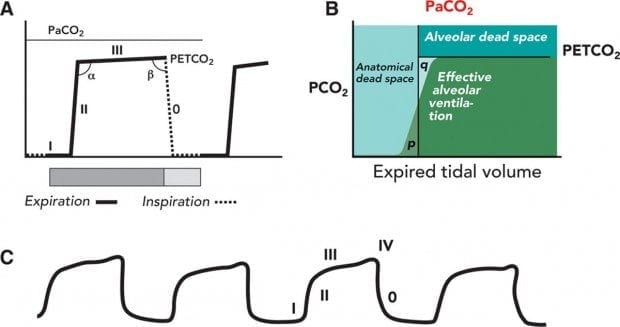normal end tidal co2 pediatric
End-tidal CO2 measured by an oralnasal cannula capnometry circuit is a noninvasive method of assessing indirect measurements of Pco2 in a normal pediatric population keywords End-tidal carbon dioxide capillary Pco capnometry oralnasal cannula. Forty-six of 96 48 95 confidence interval CI 38 58 patients had abnormal ETCO 2 values including 37 39 95 CI 29 49 with low ETCO 2 levels and.
It is the standard of care during certain procedures such as intubations and sedations and can be used in variety of clinical situations.

. This is because both hyper and hypocarbia are detrimental in this vulnerable age group. Circulating blood CO 2 is slightly greater than exhaled CO 2 due to a ventilation-perfusion VQ mismatch. In recent years flexible fiberoptic bronchoscopy FFB has been applied to children for diagnostic and therapeutic purposes.
Capnography measures the amount of CO2 present at the end of exhalation end-tidal CO2 or ETCO2 displays a waveform that represents air movement through the respiratory cycle and continuously. Sedation during FFB along with introduction of the bronchoscope into the pediatric. Capnography provides valuable timely information aboutthefunctionofboththecardiovascularandrespiratorysystems.
Pediatric Emergency Care 19939244-6. 1Memorial Miller Childrens Hospital Department of Pediatrics University of California Irvine Long Beach 90801-1428. In patients with normal pulmonary function CO 2 normally 35 to 45 mm Hg and ETco 2 should correlate closely with a deviation of about 2 to 5 mm Hg.
However et CO 2 may be underused in the PED setting. One hundred children were enrolled. So the short answer is you are right about the ranges 35-45 but that is for actual PaCo2 drawn from an ABG.
End-tidal CO 2 monitoring is the single most useful method in confirming endotracheal tube position. End-tidal carbon dioxide CO 2 monitoring is useful in the prehospital setting emergency department intensive care unit and operating room. End-tidal CO2 monitors can give healthcare providers an early warning if a patient is experiencing respiratory distress or going into respiratory failure.
For a person with normal lungs the difference between end tidal and Paco2 can vary between 5-8mmHg depending on the book your reading. The mean initial EtCO 2 value was 35 mm Hg 95 confidence interval 343 to 361 mm Hg. The end-tidal carbon dioxide level petco2 corresponds with the Paco2.
Never-theless a plateau may be absent especially in small children with a relatively high respiratory rate. As stated before end tidal is slightly different. Falk JL Rackow EC Weil MH.
Studying the arterial to end-tidal carbon dioxide difference in children undergoing laparoscopic surgeries under different intra-abdominal pressures is of extreme importance. End-tidal CO2 measured by an oralnasal cannula capnometry circuit is a noninvasive method of assessing indirect. Continuous end-tidal CO2 in pediatric bronchoscopy.
PEFR measures were completed on 43 patients and PASS recorded on 100 patients. End-tidal CO 2 et CO 2 monitoring is not a new modality in the pediatric emergency department PED and emergency department. Variability of difference scores was not related to range of mean scores r 08 age r 09 or respiratory rate r 25.
The mean disposition EtCO 2 value was 333 mm Hg 95 confidence interval 326 to 344 mm Hg. Under normal respiratory. End-tidal carbon dioxide concentration during cardiopulmonary resuscitation.
The median ETCO 2 value was 32 mmHg IQR 27 38 mmHg range 18-80 mmHg. The next inhalation may precede the purely alveolar phase of exhalation that is represented by the plateau. Practical applications of capnography.
A relative average bias of 196 with ETCO2 lower than CapCO2 was established with 95 limits of agreement of - 52 mm Hg t 571. This eliminates the need to wait for blood work chest-x-rays and other diagnostic tests. Capnographs capnometers end-tidal CO2 monitors.
N Engl J Med 1988318607-11. End-tidal CO2 monitoring allows for almost immediate information about what is going on with a patient. It should be noted that a plateau phase in the carbon dioxide waveform is mandatory.
18 Nuzzo PF Anton WR.
The Impact Of Ventilation Rate On End Tidal Carbon Dioxide Level During Manual Cardiopulmonary Resuscitation Resuscitation
Normal And Abnormal Capnography Waveforms Infographic Capnoacademy Capnoacademy
Capnography Nursing Procedures Icu Nursing Nursing School Studying
Riding The Wave Of Capnography Understanding Etco2 Vetbloom Blog
The Critical Role Of Capnography Airway Management Paramedic School Respiratory Care
End Tidal Carbon Dioxide Recording Of Ventilated Children In Picu N 535 Download Scientific Diagram
A Systematic Approach To Capnography Waveforms Jems Ems Emergency Medical Services Training Paramedic Emt News
Capno 101 How Does Capnography Work Capnoacademy Capnoacademy
5 Medical Conditions Where Capnography Can Affect Bls Care Capnoacademy Capnoacademy
End Tidal Carbon Dioxide Recording Of Ventilated Children In Picu N 535 Download Scientific Diagram
Frontiers Monitoring Expired Co2 Kinetics To Individualize Lung Protective Ventilation In Patients With The Acute Respiratory Distress Syndrome
End Tidal Capnography Can Be Useful For Detecting Diabetic Ketoacidosis Monitoring Copd Acep Now
Waveform Capnography In The Intubated Patient Emcrit Project
Waveform Capnography In The Intubated Patient Emcrit Project
End Tidal Capnography Background Indications Technical Considerations
Capnography Waveform Interpretation Litfl Ccc Equipment
